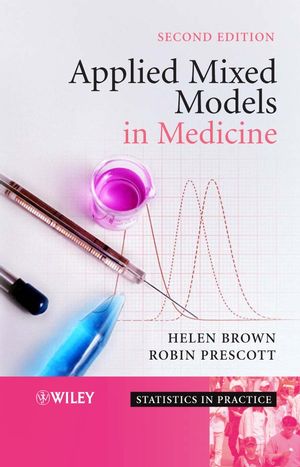Applied Mixed Models in Medicine, 2nd EditionISBN: 978-0-470-02356-3
Hardcover
480 pages
May 2006
 This is a Print-on-Demand title. It will be printed specifically to fill your order. Please allow an additional 10-15 days delivery time. The book is not returnable.
|
||||||
Mixed Model Notations.
1 Introduction.
1.1 The Use of Mixed Models.
1.2 Introductory Example.
1.3 A Multi-Centre Hypertension Trial.
1.4 Repeated Measures Data.
1.5 More aboutMixed Models.
1.6 Some Useful Definitions.
2 NormalMixed Models.
2.1 Model Definition.
2.2 Model Fitting Methods.
2.3 The Bayesian Approach.
2.4 Practical Application and Interpretation.
2.5 Example.
3 Generalised Linear MixedModels.
3.1 Generalised Linear Models.
3.2 Generalised Linear Mixed Models.
3.3 Practical Application and Interpretation.
3.4 Example.
4 Mixed Models for Categorical Data.
4.1 Ordinal Logistic Regression (Fixed Effects Model).
4.2 Mixed Ordinal Logistic Regression.
4.3 Mixed Models for Unordered Categorical Data.
4.4 Practical Application and Interpretation.
4.5 Example.
5 Multi-Centre Trials and Meta-Analyses.
5.1 Introduction to Multi-Centre Trials.
5.2 The Implications of using Different Analysis Models.
5.3 Example: A Multi-Centre Trial.
5.4 Practical Application and Interpretation.
5.5 Sample Size Estimation.
5.6 Meta-Analysis.
5.7 Example: Meta-analysis.
6 RepeatedMeasures Data.
6.1 Introduction.
6.2 Covariance Pattern Models.
6.3 Example: Covariance Pattern Models for Normal Data.
6.4 Example: Covariance Pattern Models for Count Data.
6.5 Random Coefficients Models.
6.6 Examples of Random Coefficients Models.
6.7 Sample Size Estimation.
7 Cross-Over Trials.
7.1 Introduction.
7.2 Advantages of Mixed Models in Cross-Over Trials.
7.3 The AB/BA Cross-Over Trial.
7.4 Higher Order Complete Block Designs.
7.5 Incomplete Block Designs.
7.6 Optimal Designs.
7.7 Covariance Pattern Models.
7.8 Analysis of Binary Data.
7.9 Analysis of Categorical Data.
7.10 Use of Results from Random Effects Models in Trial Design.
7.11 General Points.
8 Other Applications of MixedModels.
8.1 Trials with Repeated Measurements within Visits.
8.2 Multi-Centre Trials with Repeated Measurements.
8.3 Multi-Centre Cross-Over Trials.
8.4 Hierarchical Multi-Centre Trials and Meta-Analysis.
8.5 Matched Case–Control Studies.
8.6 Different Variances for Treatment Groups in a Simple Between-Patient Trial.
8.7 Estimating Variance Components in an Animal Physiology Trial.
8.8 Inter- and Intra-Observer Variation in Foetal Scan Measurements.
8.9 Components of Variation and Mean Estimates in a Cardiology Experiment.
8.10 Cluster Sample Surveys.
8.11 Small AreaMortality Estimates.
8.12 Estimating Surgeon Performance.
8.13 Event History Analysis.
8.14 A Laboratory Study Using aWithin-Subject 4 × 4 Factorial Design.
8.15 Bioequivalence Studies with Replicate Cross-Over Designs.
8.16 Cluster Randomised Trials.
9 Software for Fitting MixedModels.
9.1 Packages for Fitting Mixed Models.
9.2 Basic use of PROC MIXED.
9.3 Using SAS to Fit Mixed Models to Non-Normal Data.
Glossary.
References.
Index.



